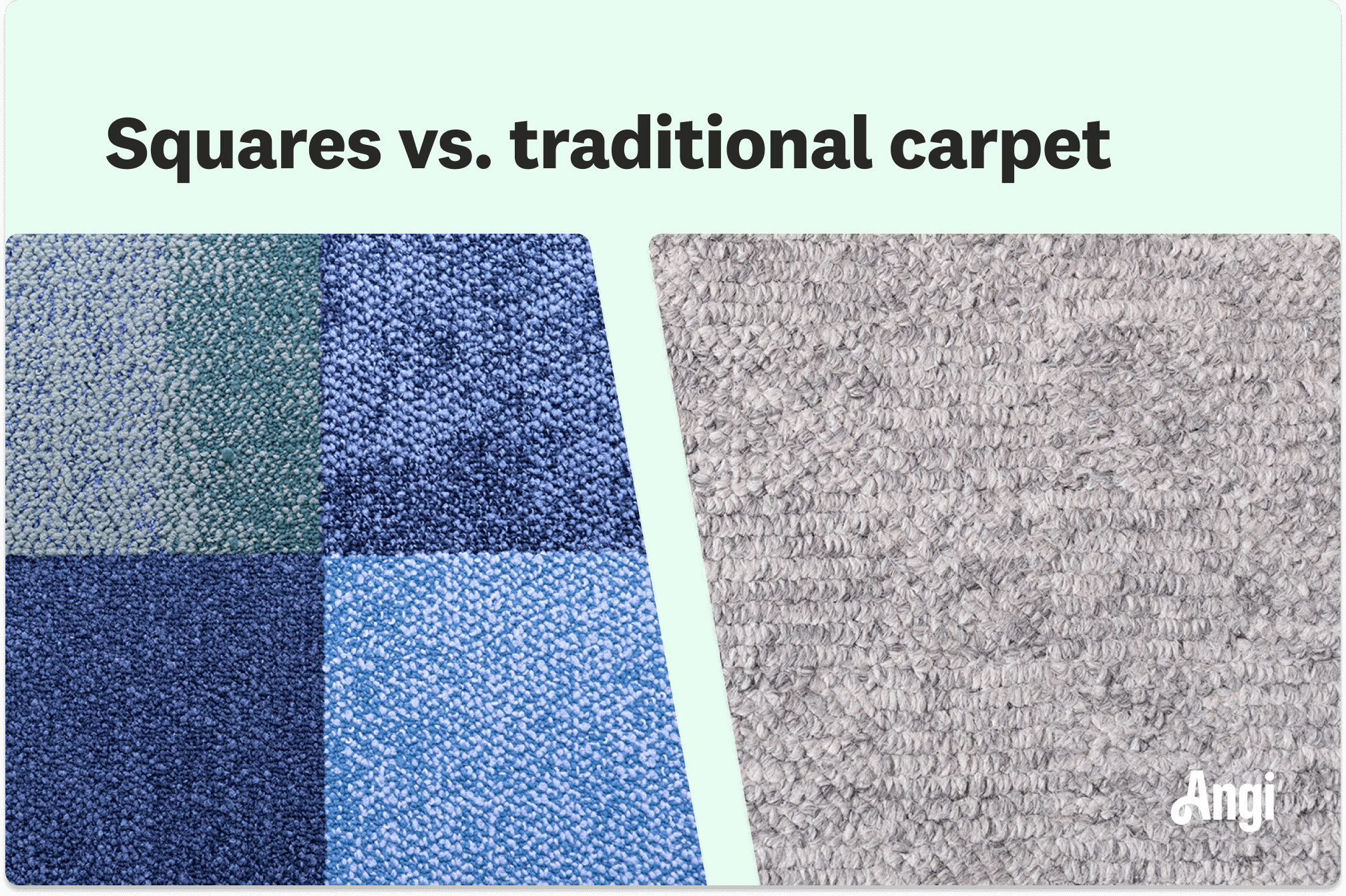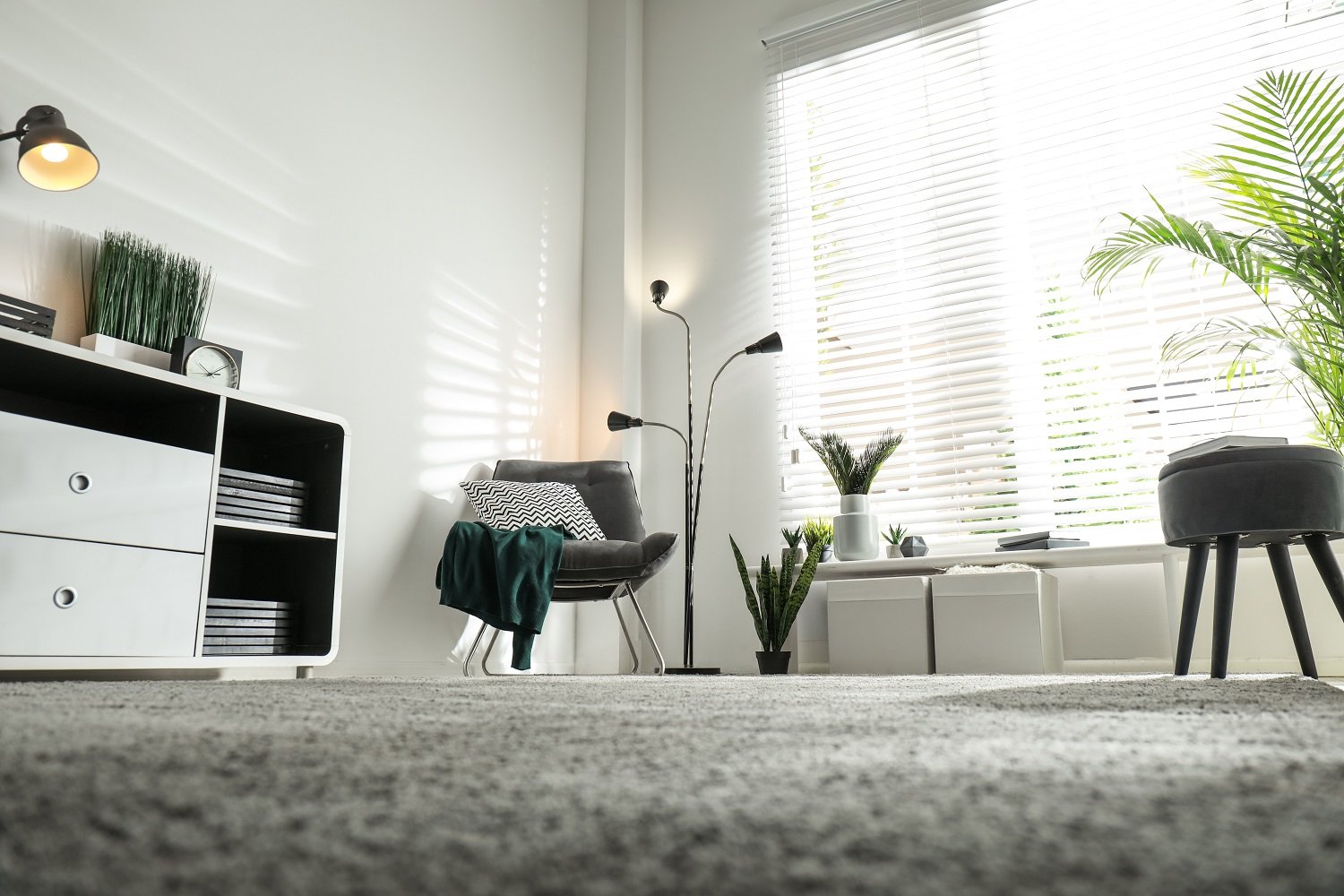What Is Carpet Tile and Is It Right for Your Home?
It’s carpet! It’s tile! No! It’s carpet tile!


Carpet tiles are cut from rolls of traditional broadloom carpet and offer flexible flooring designs for any room of the house.
You’ll pay between $2.50 and $11 per square foot in materials and labor to install carpet tiles.
Installing carpet tile is DIY-friendly, but you must take extra care to precisely line everything up.
If you think wall-to-wall carpets and area rugs are the only way to add soft flooring to a space, it’s time to meet carpet tile. This type of flooring is growing in popularity for its durability and variety of design options. Read on to learn more about what carpet tile is and whether it’s right for your space.
What Is Carpet Tile?
Carpet tiles are squares or other shapes cut out of larger rolls of carpeting. Unlike wall-to-wall carpeting, where installers must lay out an enormous roll of carpet and cut it to fit a room, carpet tiles can be installed one by one, just like regular tiles.
You can find carpet tiles in many shapes and sizes, starting at around an 18-by-18-inch square. Square tiles are the most common and easiest to install, but depending on the carpet manufacturer and the design you want for your home flooring, you can choose from geometric or other unique shapes, too.
Carpet Tile vs. Tile and Wall-to-Wall Carpet

When it comes to aesthetics and utility, there’s a lot to be said for meeting in the middle for your flooring and choosing carpet tile, also referred to as carpet squares. Carpet tiles seemingly combine the best of both flooring worlds, plus they offer countless design variations. Like with all home improvement decisions, however, you need to determine whether it’s a good match for your space.
Regular tile might still be the better flooring option for high-traffic areas because it’s so easy to clean. It’s especially good in moisture-prone areas like kitchens, bathrooms, and basements, where it can easily be mopped in case of a spill. That’s not to say that wall-to-wall carpet isn’t also durable and easy to clean, of course, provided you have a good vacuum and carpet steamer. There are many types of carpets that are designed to last for years, even when pets and children are added to the mix.
On average, carpet tile costs between $2.50 and $11 per square foot installed. Standard tile costs can range between $5 and $45 per square foot, and wall-to-wall carpet costs between $3 and $11 per square foot just to install it (not including material costs).
Pros and Cons of Carpet Tile
Let’s take a closer look at some of the advantages and disadvantages of carpet tile.
| Pros | Cons |
|---|---|
| Easy to install | Not a seamless appearance |
| Easy to replace | Can “move” after installation |
| Wide variety of design options | Rubber backing can warp |
Pros
Here are some of the top reasons carpet tile has been gaining popularity.
Easy to Install
DIYers, rejoice. Rather than wrangling a huge roll of carpet or worrying about adding too much (or too little) grout for tile, carpet tile installation can be as simple as laying down whole carpet tiles until the room is filled. Yes, you’ll have to trim some tiles to fit at one point, but cutting a carpet tile is a lot easier than cutting a carpet roll or individual porcelain tiles.
Easy to Replace
When wall-to-wall carpet is stained or damaged, you’ll eventually need to replace all of the carpet (or at least get creative with furniture placement). This isn’t the case with carpet tiles. Just as you can install them one by one, you can replace them one by one. Not only is this a fast fix, but it’s an inexpensive one, too—especially if you’ve got extras on hand from when you initially installed it.
Variety of Design Options
Color and texture might be top of mind when choosing wall-to-wall carpeting or area rugs, but carpet tile opens up many more design opportunities than its flooring counterparts. For starters, you can get samples of tiles and experiment with designs and placement without a full installation—something that’s hard to do with an area rug and nearly impossible with wall-to-wall. And considering carpet tile’s durability, you have the option of installing it in just about any high-traffic area, including outdoors.
Cons
Carpet tile is a great solution for many homes, but keep in mind these drawbacks while you’re shopping for flooring.
Rough Edges Might Be Visible
Even experienced installers will admit that perfection isn’t possible with carpet tile. While wall-to-wall carpet has a seamless aesthetic because it’s all one piece, carpet tiles need to be fitted together. Yes, this means you’ll see seams, some of which can fray over time.
Tiles Can Shift After Installation
Although carpet tiles are vastly easier to install than regular tile, they can shift over time. In fact, shortly after you complete an installation, you might start to see the joints widen between tiles. Poor cuts in the tiles will definitely be visible.
Rubber Base Can Warp
One of the most advantageous features of carpet tile—the rubber backing—can actually be a disadvantage, too. While the rubber base does make it more durable than regular carpet or tile and is suitable even for outdoor use, it can warp in extreme temperatures. This can lead to an uneven look and underfoot feel.
Should I DIY Carpet Tile Installation or Hire a Pro?
You can DIY carpet tile, but if you don’t have the time or trust your skills, call a local carpet installer, instead. A seasoned professional can ensure the job is done right and done quickly—or at least quicker than a DIYer who is just getting the hang of carpet tiles.





- Carpet Tiles vs. Carpet: Which One Will Floor You?
- Can You Put Carpet Over Tile? Here’s What You Need to Know
- 4 Types of Carpet Tiles and How to Choose
- How Long Does Carpet Last? 7 Signs You Need to Replace It
- Can You Put Carpet Over Carpet? Pros, Cons, and Best Practices
- How to Choose Carpet for Any Room of Your Home
- How to Dispose of Carpet Properly
- How to Disinfect Carpet: Facts, Myths, and What You Can Do Yourself
- Common Causes of Carpet Wrinkles and How to Prevent Them
- 7 Types of Flooring That Can Be Laid Over Carpet










